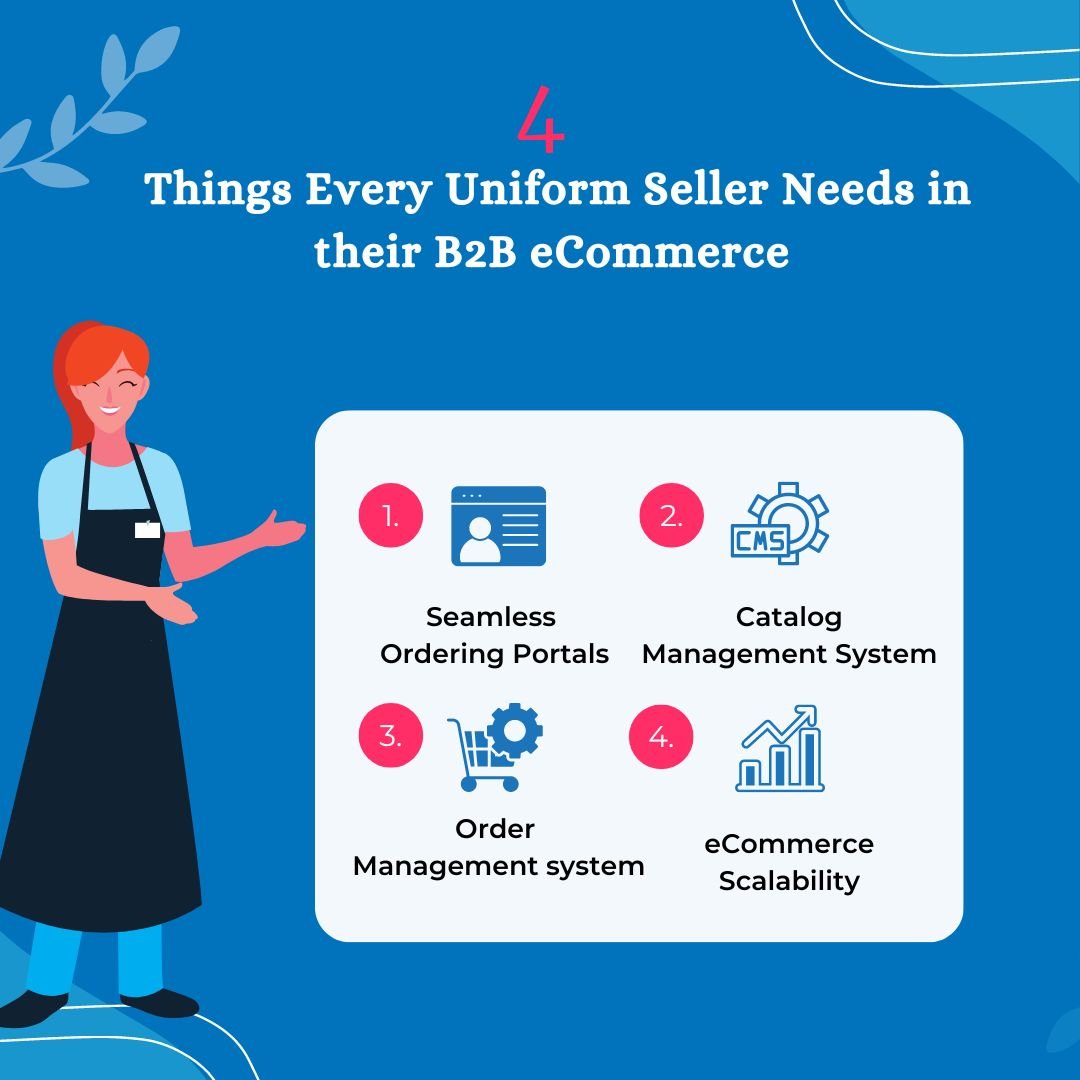
Sales on B2B eCommerce sites, log-in portals, and marketplaces increased to $1.63 trillion in the past few years, according to Digital Commerce 360. Statista data suggests that the North American B2B eCommerce market will surpass $4,600 billion by 2025.
The numbers are rising and they will continue to do so in the foreseeable future. With respect to the uniform industry, uniform businesses catering to frontline workers and medical professionals encountered an unexpected rise in demand during the pandemic that drove them to increase production. Hospital chains, clinics, and diagnostic centers, since the outbreak of the coronavirus, have become extremely particular about the uniforms that personnel wear to work.
They are willing to go that extra mile to make sure that every employee receives the right uniform kit assigned to them based on their job role.
As such, a streamlined way of uniform delivery via an eCommerce platform that can help both businesses and buyers cut down on manual operation, eliminate wrong orders, and enable control over uniform expenditure is the need of the hour.
Whether you are planning to start a uniform eCommerce business or you are looking to scale up your existing business, there are certain essentials a uniform seller needs in B2B eCommerce.

Successful B2B businesses have one thing in common: they understand their B2B buying process and work towards improving it. If your website can’t set you apart from the competitors it is easy to lose your customers.
To offer an ideal customer experience and make it easy for others to do business with you, you need an eCommerce platform with features built specifically for B2B uniform duty. To successfully address the needs of their online buyers and succeed in the competitive market, B2B uniform sellers must equip their web stores with several key features for B2B eCommerce.
Digital Commerce 360 reports that 42% of distributors say creating a more sophisticated website to better meet customer needs is one of the biggest challenges.
Fortunately, today solutions like advanced uniform management systems built with keeping in the mind the essential features across all employee uniform stores (hospital, industrial, corporate, tactical, hospitality, etc.) leverage employee data and craft a stellar buying experience.
Here are some of the ways a tailor-made uniform ordering portal paves the way for a simplified buying experience:
Web portals are tailor-made for every business in accordance with their stipulated uniform rules and can only be accessed by authorized employees and company staff in charge of managing the uniforms. It also integrates with the customer’s ERP & HRMS systems to deliver a hyper-personalized uniform buying experience to employees.
Also read: How Uniform Management Systems Are Making Uniform Providers Digitally Fluent
Product catalogs are essential marketing tools that companies use to assist customers in making knowledgeable purchasing decisions since they include comprehensive product information.
However, maintaining them online can be a laborious effort because they need to be updated frequently with the most recent product information. Buyers won't be aware of changes in pricing, discontinued SKUs, or new product releases unless the catalogs are updated.
Here’s where PIM (Product information management) software or automated catalog management solutions comes into the picture. Such tools will gather all your product information into one single place, manage, and enrich your product information, create a product catalog, and distribute it to your sales and eCommerce channels ensuring consistent and updated information is displayed to customers.
With automating catalog management, uniform sellers can select and subscribe to top uniform supplier's catalogs, choose import methods, map catalog details, review and hit publish on multiple sales channels.
An OMS helps uniform sellers organize and automate key parts of the purchasing/fulfillment processes for them and their customers. After an order is placed and a delivery method is selected, an automated process is triggered for fulfillment.
Whether it’s shipping from the nearest and/or most cost-effective location, or preparing the item for in-store pickup, OMS platforms help sellers fulfill orders quickly. It also helps monitor inventory levels to avoid stockouts and backorders and even manage other steps in the customer lifecycle, such as returns.
It enables your employees and customers to view and track each order from start to finish, and it helps analyze the overall efficiency of the process.
Having an e-commerce site that you can easily scale to accommodate your web store’s growing audience is crucial. When Prime Day online traffic spiked in 2018, Amazon's website was unable to manage it, directing consumers who were trying to complete a purchase to the homepage and preventing them from checking out.
This issue lasted for an hour and it was estimated that it cost Amazon about $1,000,000 per minute because it happened during the peak hours of Prime Day.
True e-commerce scalability must check the following boxes:
![]() Today UniformMarket can seamlessly deal with:
Today UniformMarket can seamlessly deal with:
UniformMarket offers an eCommerce platform with headless commerce capabilities, industry-leading hands-on customer support, and 80+ web content management and eCommerce features.
Get in touch today.